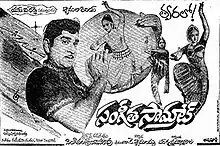Sangeeta Samrat
Sangeeta Samrat (transl. Musical Emperor) is a 1984 Telugu-language romance film, produced by K. Shyamalamma under the Shyamala Films banner and directed by Singeetham Srinivasa Rao.[2] It stars Akkineni Nageswara Rao, Jaya Prada and music composed by Ramesh Naidu.[3]
| Sangeeta Samrat | |
|---|---|
 Theatrical release poster | |
| Directed by | Singeetham Srinivasa Rao |
| Produced by | K. Shyamalamma |
| Written by | Rajashri (dialogues) |
| Screenplay by | Singeetham Srinivasa Rao |
| Story by | K. Shymalamma |
| Starring | Akkineni Nageswara Rao Jaya Prada |
| Music by | Ramesh Naidu |
| Cinematography | P. S. Selvaraj |
| Edited by | Gowtham Raju |
Production company | Shyamala Films[1] |
Release date |
|
Running time | 134 mins |
| Country | India |
| Language | Telugu |
Plot
The film begins in a village where Gopi (Akkineni Nageswara Rao) an orphan, who has a god gift talent of music. Everyone in the village is affectionate towards him due to his amicable nature, in turn, he too treats them as his family. Once there is a marriage in the village when Gopi takes up the entire responsibility. The bride goes to the city to invite her music mentor Viswanatha Sastry (Gummadi) along with few friends. Radha (Jaya Prada) an extraordinary dancer is one among them, currently, Gopi falls for her. During the time of the wedding, Gopi aspires Radha to dance for his music when she insults him. Parallelly, Viswanatha Sastry gazes at the art of Gopi and offers to join as his disciple to which Gopi refuses. But after learning Radha's ambition is to marry a person who is the potential to sing for her dance. So, immediately, he moves to the city, works hard and becomes a scholarly musician when Radha too loves him. On the other side, Narasimha Sastry (Dhulipala) a haughty person, always grudges against Viswanatha Sastry and trains his son Poorna Chandra (Narasimha Raju) and daughter Malini (Jayamalini) to vie with disciples of Viswanatha Sastry. Meanwhile, Gopi is ostracized from the institute for the offence he has not made when Radha also loathes him, but later they realize the truth. At the same time, cultural competitions are held in which Malini seeks price against Radha. Here, Narasimha Sastry swindles by marring the voice of Viswanatha Sastry. During that plight, Gopi arrives and protects the honor of his mentor. Thereafter, Gopi & Radha leaves for a foreign tour and gains great fame. At that point in time, Narasimha Sastry humiliates Viswanatha Sastry that he does not have a perfect skillful disciple. Right now, Viswanatha Sastry decides to prepare Gopi for nationals to acquire the title of Sangeeta Samrat but as Gopi is completely immersed in Radha's love and not able to concentrate on music. Being cognizant of it, Viswanatha Sastry behests Radha to get discard from Gopi's life which she does so. But Gopi could not tolerate the betrayal of Radha, so, he becomes a drunkard. Knowing it, Viswanatha Sastry collapses when Gopi promises to establish his glory. During the time of competition, unfortunately, Gopi gets demotivated when Radha lands on time makes him win. At last, Viswanatha Sastry also understands the divine relation of the couple and even Narasimha Sastry also pleads pardon from him. Finally, the movie ends on a happy note with the marriage of Gopi & Radha.
Cast
- Akkineni Nageswara Rao as Gopi
- Jaya Prada as Radha
- Gummadi as Viswanatha Sastry
- Dhulipala as Narasimha Sastry
- Ramakrishna as Sudhakar
- Narasimha Raju as Poorna Chandra
- Sarathi
- Krishna Murthy Raju as Balaji
- Jayamalini as Malini
Crew
- Art: Bhaskar Raju
- Choreography: Krishna Murthy Raju, Prakash, Surekha
- Stills: Mohanji-Jaganji
- Dialogues: Rajashri
- Lyrics: Veturi Sundararama Murthy
- Playback: SP Balu, P. Susheela, S. P. Sailaja, Poorna Chandra Rao, Krishna Murthy Raju
- Music: Ramesh Naidu
- Editing: Gowtham Raju
- Cinematography: P. S. Selvaraj
- Story - Producer: K. Shyamalamma
- Screenplay - Director: Singeetham Srinivasa Rao
- Banner: Shyamala Films
- Release Date: 28 November 1984
Soundtrack
| Sangeeta Samrat | ||||
|---|---|---|---|---|
| Film score by | ||||
| Released | 1984 | |||
| Genre | Soundtrack | |||
| Length | 47:36 | |||
| Label | SEA Records | |||
| Producer | Ramesh Naidu | |||
| Ramesh Naidu chronology | ||||
| ||||
Music composed by Ramesh Naidu. Lyrics were written by Veturi Sundararama Murthy. Music released on SEA Records Audio Company.[4]
| S. No. | Song Title | Singers | length |
|---|---|---|---|
| 1 | "Sangeetham" | SP Balu, Poorna Chandra Rao | 4:31 |
| 2 | "Nayana Hridhaya" | SP Balu | 6:13 |
| 3 | "Naatyame Naa Aaraadhana" | P. Susheela, S. P. Sailaja, Poorna Chandra Rao | 6:57 |
| 4 | "Entha Sogasugaade" | P. Susheela, Krishna Murthy Raju | 4:13 |
| 5 | "Idhi Kannulu Palike" | SP Balu, P. Susheela | 4:40 |
| 6 | "Prema Neekokka Namaskaram" | SP Balu | 4:19 |
| 7 | "Jamuratri" | SP Balu | 4:45 |
| 8 | "Jadivaana Padutunte" | SP Balu, S. P. Sailaja | 4:19 |
| 9 | "Sangeetham" | SP Balu, Poorna Chandra Rao | 7:39 |
References
- "Sangeeta Samrat (Overview)". IMDb.
- "Sangeeta Samrat (Cast & Crew)". gomolo.com.
- "Sangeeta Samrat (Review)". Know Your Films.
- "Sangeeta Samrat (Songs)". Music India Online.